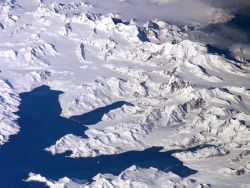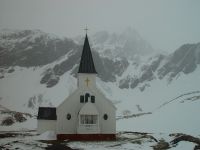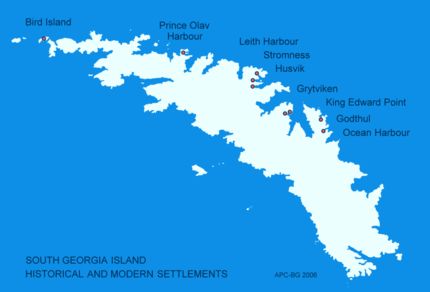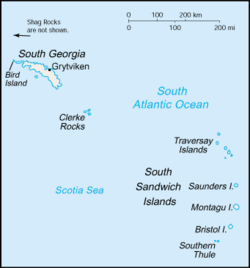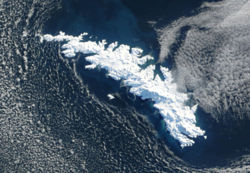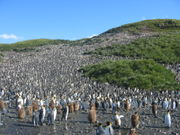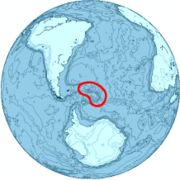South Georgia and the South Sandwich Islands
2007 Schools Wikipedia Selection. Related subjects: Antarctica
|
|||||
| Motto: Leo Terram Propriam Protegat (Latin: "Let the Lion protect his own land" or "May the Lion protect his own land") |
|||||
 |
|||||
| Official language | English | ||||
| Capital | Grytviken | ||||
| Commissioner | Andrew George | ||||
| Area - Total - % water |
not ranked 3,903 km² - |
||||
| Population - Total (2006 E) - Density |
not ranked ~20 n/a; |
||||
| Currency | GBP | ||||
| Time zone | UTC/GMT -2 | ||||
| National anthem | God Save the Queen | ||||
| Internet TLD | .gs | ||||
South Georgia and the South Sandwich Islands (SGSSI) is an overseas territory of the United Kingdom in the southern Atlantic Ocean. The territory was formed in 1985; previously it was governed as part of the Falkland Islands Dependencies. It is a remote and inhospitable collection of islands, consisting of South Georgia – which measures approximately 100 miles by 18 miles and is by far the largest island in the territory – and a group of smaller islands known as the South Sandwich Islands. There is no native population on any of the islands, and the only inhabitants are the British Government Officer, scientists and support staff from the British Antarctic Survey who maintain scientific bases at Bird Island and the capital, King Edward Point, and museum staff at nearby Grytviken.
The British sovereignty of South Georgia dates from 1775, and that of the South Sandwich Islands from 1908. British arrangements for the government of South Georgia were first established under the 1843 British Letters Patent, with permanent local British administration and resident Magistrate since 1909 exercising effective possession, enforcement of British law, and regulation of all economic, scientific and other activities in the territory.
Argentina claimed South Georgia in 1927 and the South Sandwich Islands in 1938. From 1905 the Argentine Meteorological Office cooperated in maintaining the meteorological observatory at Grytviken under the British lease requirements of the whaling station until these changed in 1949. Argentina maintained a naval station on the South Sandwich Islands from 1976 until 1982 when it was closed by the United Kingdom, and briefly occupied South Georgia in 1982. The Argentine claim of SGSSI contributed to the 1982 Falklands War and has remained unresolved until today.
History
South Georgia
The Island of South Georgia is said to have been first sighted in 1675 by Anthony de la Roche, a London merchant, and was named Roche Island on some early maps. It was rediscovered in 1775 by Captain James Cook, who, after dismissing his find as "not worth the discovery," went on to survey and map the island, make the first landing, claim the territory for the Kingdom of Great Britain, and name it "the Isle of Georgia" in honour of King George III.
In 1882 a German expedition sent out to observe the transit of Venus was stationed at Royal Bay on the south-east side of the island.
Throughout the 19th century South Georgia was a sealers' base and, in the following century, a whalers' base until whaling ended mid-century. The first land-based whaling station, Grytviken, was set up in 1904 and was in operation until 1965. The seven whaling stations, all on the north coast with its sheltered harbours were, starting from the west:
- Prince Olav Harbour (from 1911 factory ship, land-based station 1916–1934)
- Leith Harbour (1909–1965)
- Stromness (from 1907 factory ship, land-based station 1912–1931, repair yard to 1960/1961)
- Husvik (from 1907 factory ship, land-based station 1910–1960, not in operation 1930–1945)
- Grytviken (1904–1965)
- Godthul (1908–1929, only a rudimentary land base, main operations on factory ship)
- Ocean Harbour (1909–1920)
During World War II, the Royal Navy deployed an armed merchant vessel to patrol South Georgian and Antarctic waters against German raiders, along with two four-inch shore guns (still present) protecting Cumberland Bay and Stromness Bay, manned by volunteers from among the Norwegian whalers.
The Falklands War was precipitated on 19 March 1982 when a group of Argentineans, posing as scrap metal merchants, occupied the abandoned whaling station at Leith Harbour on South Georgia. On April 3 the Argentine troops attacked and occupied Grytviken. Among the commanding officers of the Argentinian Garrison was Alfredo Astiz, a Captain in the Argentine Navy who, years later, was convicted of felonies committed during the Dirty War in Argentina. The island was recaptured by British forces on 25 April ( Operation Paraquat).
The research station at King Edward Point, near the former Norwegian whaling station of Grytviken, was originally established as an administrative centre and residence of the British Magistrate in 1909, then expanded as a research facility in 1949/1950 by the British Antarctic Survey (until 1962 called Falkland Islands Dependencies Survey). It became a small military garrison after the Falklands war, but returned to civilian use in 2001 and is now operated by the British Antarctic Survey.
South Sandwich Islands
The southern eight islands of the Sandwich Islands Group were discovered by James Cook in 1775; the northern three by Fabian Gottlieb von Bellingshausen in 1819.[ clarification needed] They were named "Sandwich Land" by Cook after the 4th Earl of Sandwich, 1st Lord of the Admiralty. The word "South" was added to distinguish them from the "Sandwich Islands", now known as " Hawaii".
The United Kingdom claimed South Georgia in 1775 and formally annexed both South Georgia and the South Sandwich Islands in 1908, grouping them with other British-held territory in Antarctica as the Falkland Islands Dependencies. Argentina later claimed the islands in dispute with the UK (See Sovereignty of the Falkland Islands).
Argentina challenged British sovereignty in the Islands on several occasions. From January 25, 1955 through summer of 1956 Argentina maintained the summer station Teniente Esquivel at Ferguson Bay on the Southeastern coast of Thule Island. From 1976 to 1982, Argentina maintained a naval base named Corbeta Uruguay, at Port Faraday, in the lee (southern East coast) of the same island. Although the British discovered the presence of the Argentine base in 1978, no effort was made to remove them until after the Falklands War. The base was eventually removed on June 20, 1982.
Geography
South Georgia and the South Sandwich Islands are a group of bleak and remote islands in the South Atlantic Ocean. Most of the islands, rising steeply from the sea, are rugged and mountainous; South Georgia is largely barren and has steep, glacier-covered mountains; the South Sandwich Islands are of volcanic origin with some active volcanoes. Mount Paget on South Georgia is 2,934 m high.
The climate in the islands is variable and harsh, with mostly westerly winds throughout the year interspersed with periods of calm. Typical daily maximum temperatures in South Georgia at sea level are around 0°C (32°F) in winter (August) and 10°C (50°F) in summer (January). Winter minimum temperatures are typically about −5°C (23°F) and rarely dip below −10°C (14°F). Annual precipitation in South Georgia is about 1500 mm (59 in), much of which falls as sleet or snow.
The prevailing weather conditions generally make the islands difficult to approach by ship, though the north coast of South Georgia has several large bays which provide good anchorage. Reindeer, introduced early in the 20th century, and a large colony of King Penguins live on South Georgia.
South Georgia Group
South Georgia lies about 1390 km east-southeast of the Falkland Islands, at 54°-55°S, 36°-38°W. The South Georgia group of islands comprises South Georgia itself (by far the largest island in the territory), along with the islands that immediately surround it and some remote and isolated islets to the west and east-southeast. It has a total land area of 3756 km², including satellite islands (but excluding the South Sandwich Islands which form a separate island group).
The island of South Georgia itself, also called Pepys Island (San Pedro in Spanish), has an area of 3528 km². It is mountainous, with 11 peaks over 2,000 m high, their slopes furrowed with deep gorges filled with glaciers ( Fortuna Glacier being the largest). Geologically, it consists of gneiss and argillaceous schists, with no trace of fossils, showing that the island is, like the Falkland Islands, a surviving fragment of some greater land-mass now vanished, most probably indicating a former extension of the Andean system.
Islands in the South Georgia Group
- South Georgia Island (the main island),
Smaller islands and islets off the coast of South Georgia Island:
- Bird Island
- Annenkov Island
- Cooper Island
- Pickersgill Islands
- Welcome Islands
- Willis Islands
- Trinity Island
Remote rocks:
- Shag Rocks 185 km west-northwest of South Georgia Island
- Black Rock 169 km west-northwest of South Georgia Island and 16 km southeast of the Shag Rocks
- Clerke Rocks 56 km east-southeast of South Georgia Island
South Sandwich Islands
The South Sandwich Islands (Spanish name: Islas Sandwich del Sur) comprise 11 mostly volcanic islands (excluding tiny satellite islands and rocks nearby those main islands). They form an island arc running from north to south in the region 56°18'–59°27'S, 26°23'–28°08'W, about 450 miles south east of South Georgia.
The northernmost of the South Sandwich Islands form the Traversay Islands and Candlemas Islands groups, while the southernmost make up Southern Thule. The three largest islands – Saunders, Montagu and Bristol – lie between the two. The Islands' highest point is Mount Belinda (1370 m) on Montagu Island.
The South Sandwich Islands are uninhabited, though a permanently manned Argentinian research station was located on Thule Island from 1976 to 1982 (for details, see "History" section above). There are automatic weather stations on Thule (Morrell) Island and Zavodovski. To the northwest of Zavodovski Island is the Protector Shoal, a submarine volcano.
The following table lists the South Sandwich Islands from north to south:
| Island (Spanish Name) | Area (km²) | Highest Peak (m) | Location | |
| Traversay Islands | ||||
| Protector Shoal | - | Protector Shoal (-27 m) | ||
| Zavodovski | 25 | Mount Curry (550 m) | ||
| Leskov | 0.3 | Rudder Point (190 m) | ||
| Visokoi | 35 | Mount Hodson (915 m) | ||
| Candlemas Islands (sometimes included with Traversay Islands) | ||||
| Candlemas (Candelaria) | 14 | Mount Andromeda (550 m) | ||
| Vindication (Vindicación) | 5 | Quadrant Peak (430 m) | ||
| Central islands | ||||
| Saunders | 40 | Mount Michael (990 m) | ||
| Montagu (Jorge) | 110 | Mount Belinda (1370 m) | ||
| Bristol (Blanca) | 46 | Mount Darnley (1100 m) | ||
| Southern Thule | ||||
| Bellingshausen | 1 | Basilisk Peak (255 m) | ||
| Cook | 20 | Mount Harmer (1115 m) | ||
| Thule or Morrell Island (Tule del Sur) |
14 | Mount Larsen (710 m) | ||
| South Sandwich Islands | 310 | Mount Belinda (1370 m) | ||
Politics
Executive power is vested in The Queen and is exercised by the Civil Commissioner, a post held by the Governor of the Falkland Islands. The current Commissioner is Andrew George who succeeded Alan Huckle on 10th July 2006. An Assistant Commissioner deals with policy matters and is also Director of SGSSI Fisheries, responsible for the issue of fishing licenses. An Operations Manager deals with administrative matters relating to the territory. The Financial Secretary and Attorney General of the territory are appointed and hold similar appointments in the Falkland Islands' Government.
As there are no permanent inhabitants on the islands, there is no legislative council and no elections are held. The UK Foreign Office manages the foreign relations of the territory. Since 1982, the territory celebrates Liberation Day on June 14.
The constitution of the territory, the manner in which its government is directed, and the availability of judicial review were discussed in a series of litigations in 2001 to 2005; see in particular Regina v. Secretary of State for Foreign and Commonwealth Affairs (Appellant) ex parte Quark Fishing Limited [2005] UKHL 57. Although its government is entirely directed by the UK Foreign Office, it was held that its decisions under that direction could not be challenged as if they were in law decisions of a UK government department; thus the European Convention on Human Rights did not apply.
Economy
As there are no native inhabitants, economic activity in South Georgia and the South Sandwich Islands is limited. The territory has revenues of UK£3.9 million, 90% of which is derived from fishing licences (2002 figures) . Other sources of revenue are the sale of postage stamps and coins, tourism and customs and harbour dues.
Fishing
Fishing takes place around South Georgia and in adjacent waters in some months of the year, with fishing licences sold by the territory for Patagonian toothfish, icefish and krill. Fishing licences bring in a handful of million pounds a year, most of which is spent on fishery protection and research. All fisheries are regulated and managed in accordance with the Convention for the Conservation of Antarctic Marine Living Resources (CCAMLR) system. In 2001, the South Georgia government received a certificate from the Marine Stewardship Council for its sustainable Patagonian toothfish fishery, which certifies that they met the MSC's environmental standards and places limits on the timing and quantity of Patagonian toothfish that may be caught.
Tourism
Tourism has become a larger source of income in recent years, with many cruise ships visiting the islands. The territory gains income from landing charges.
Postage stamps
A large source of income from abroad also comes from the issue of South Georgia and the South Sandwich Islands postage stamps which are produced in the UK.
A reasonable policy (few sets of stamps are issued each year) along with attractive subject matter (especially whales) makes them very popular with topical stamp collectors.



